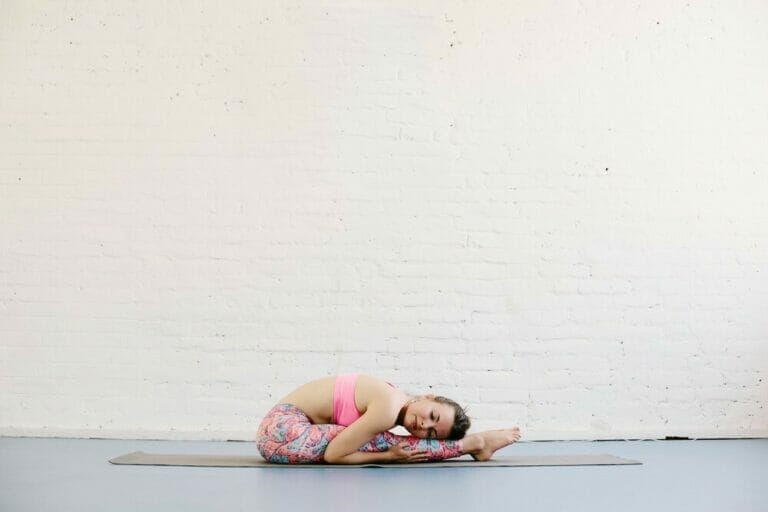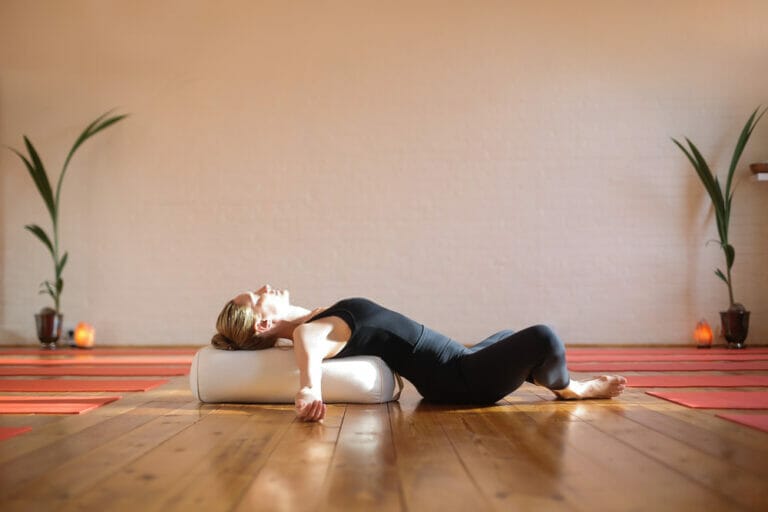Good or Bad – All You Need To Know About Hot Yoga
Artificial heat is the latest rage. People are paying large sums of money to purge their exhaustion, calories, and toxins.
Among one of the most critical wellness trends, Hot Yoga is a big trend right now.
Though it’s been gaining momentum for years and attracts many followers each year, there is also a lot of scepticism about mainstream practice.
Critics say it’s just a marketing scam full of false announcements and unsubstantiated boons to increase revenue.
However, is this true? To answer that question in one sentence, no, it is not. You need to understand the pros and cons of hot Yoga before ever signing up for class.
This article aims to break down the myths surrounding hot Yoga so you can make an informed decision on whether it’s right for you or not!
What is Hot Yoga?
Hot Yoga is a type of yoga done in a room heated up to 100 degrees Fahrenheit. The class lasts for about 90 minutes and consists of a series of yoga postures.
It can be considered as an alternative form of exercise because it burns calories like any other workout.
Practitioners widely believe that sweating is beneficial to health as it detoxifies the body. It also makes the body feel good, creates a sense of well-being, and improves flexibility.
Bikram Choudhury, a notorious yoga guru, founded hot Yoga in the 1970s. It was supposed to imitate the climate of his home town Kolkata, India.
Choudhury’s living space was heated to 105 degrees Fahrenheit and maintained at 40% humidity, which caused the body to sweat profusely.
It helped the body to naturally cleanse and detoxify itself, maintaining optimum health and maximum function.
Traditional Bikram studios still keep the rooms at 105 degrees Fahrenheit. It's called a "Torture Chamber," as Choudhury called his living spaces.
However, other newly emerging styles of Yoga, such as Baron Baptiste Vinyasa or Moksha yoga, vary their temperature between 85 to 100° F.
Hot Yoga Benefits
There are various health benefits associated with hot Yoga and many myths that are not true.
Let’s explore some benefits of hot Yoga:
It Burns Calories:
More intensity and pace in movements make hot Yoga a good option for weight loss. Likewise, vinyasa-based yoga routines are good for weight loss because they require more activity power and rate.
The heat aspect of hot Yoga also helps because it increases the heart rate and makes you sweat more during the exercise, which increases calorie burning.
It has been mentioned in a paper in the "International Journal of Yoga Therapy," which says,
Hot yoga classes advertise the number of calories you burn in a class by the increased temperature. However, raising your heart rate can make for a more strenuous workout.
This additional effort will help you burn more calories!
So if you’re a hot yoga junkie, there are some benefits of doing it in addition to your usual workout. Hot Yoga can help you with weight loss and reach your fitness goals more quickly.
It Can Increase Flexibility
It is one of the more apparent benefits of practising hot Yoga.
If you start practising Yoga but find that most poses are challenging, switching to a hot yoga studio could be more beneficial for you as hot Yoga improves flexibility even more than the Normalyoga.
A study assessing the effects of hot yoga and a form of non-thermal Yoga found that participants had an extra 10% increase in flexibility during the hot yoga session compared to standard Yoga.
The heat does more than make you sweat; it also helps loosen up your muscles and joints. When you’re in the heat, your muscle’s flexibility increases, which can give you more range of motion with your practice.
Improved circulation can also reduce soreness and pain!
While you might be put off a little by the added heat in a yoga studio, it can soon make it worth the sweat.
It Reduces Stress:

Those who regularly practise yoga say that a regular ‘Bikram’ night or morning helps them unwind better. It is because it squeezes out all the toxins which cause stress in your body.
In addition, the stretch of muscles combined with high temperature is said to calm anxiety and give you a sense of relaxation.
Hot Yoga is proven to reduce stress by teaching mindfulness techniques like breathing and meditation. The practitioner focuses on deep breathing to calm the body and lower the heart rate.
Breathing exercises like this can help you calm your mind. Mindfulness and deep breathing can also handle mental health issues like anxiety.
Instead of going for a high-intensity, fast-paced exercise routine, try incorporating some hot yoga poses into your workouts to build strength and stamina, but with a little more focus on the mind.
It Reduces Pain And Inflammation:
Some people suffer from frequent joint pain and inflammation, especially if they are over-stressed or overworked.
Research has shown that hot yoga can be beneficial for reducing pain and reducing inflammation in your body.
The heat helps heal the muscles around the painful joints by increasing circulation while toning and lengthening them.
The heat also helps you relax, which is very important because it can reduce stress and stiffness brought on by stress and tension.
Regulate Blood Sugar
Indeed, this is correct; hot Yoga can even help keep one’s blood sugar in a healthy range.
It can be attributed to two main factors: the stress-relieving side of Yoga and that Yoga is also an exercise.
For people with diabetes, high blood sugar levels can be dangerous. High blood sugars can have harmful effects on long-term health if left untreated.
It can cause damage to the kidneys and eyes, and even short-term side effects such as severe dehydration and diabetic ketoacidosis.
One underlying cause of hyperglycemia is stress. Therefore, people with diabetes have to be careful about pressure.
For type 1s, stress is extra dangerous because of the lack of insulin. For type 2s, it’s important to practice techniques that reduce stress and exercise to release endorphins.
It is what Hot yoga and its attributes have to offer!
The meditative and mindful techniques of hot Yoga are a beneficial way to relieve stress in diabetics. In addition, yoga is a gentle form of exercise that can help lower high glucose levels and improve circulation.
The Journal of Bodywork and Movement Therapies found that hot yoga can help lower blood glucose levels in the bloodstream of older participants.
A note to people with diabetes participating in hot Yoga: don’t forget about the heat. Also, use great care because blood glucose could deteriorate too low.
Improves Your Skin
Beginners might not be able to see why sweating in hot Yoga is a benefit. Sweat helps maintain the human body’s health.
Sweating releases toxins and beneficial bacteria from the body. It is how the body cleans out your pores and keeps the skin blemish-free. The skin is constantly exfoliating itself with this process.!
It can be beneficial for those with oily skin or who are prone to acne.
Aids the Lymphatic System
The body has two systems for fighting disease: the immune system and the lymphatic system. The lymphatic system is just as important as the immune system because it fights off infections.
The human body is a complex system of organ and tissue networks. It creates the circulatory and immune systems.
In addition, it has the primary function of transporting lymph around the body, including white blood cells. Lymph acts as an antioxidant that generates protection from invaders and has the potential to destroy cancer cells.
As I mentioned earlier, Hot Yoga helps rid your body of toxins. It's like an extra boost for the lymphatic system.
The lymphatic system is one of the body’s natural defences. It helps filter harmful toxins from the bloodstream by sending white blood cells to invade organisms and bacteria.
Hence, when we sweat and expel toxins, we are benefiting the lymphatic system! Hot Yoga is a workout that will make you sweat, which will help your body get rid of toxins.
A robust lymphatic system will let the body fight off disease and infections.
Strengthens Bones
It is correct that hot Yoga can aid in synthesizing bone tissue, causing increased bone density.
However, the essential health benefit of hot yoga is that it helps older practitioners maintain their bone density.
But how are we doing this?
It’s pretty simple: Yoga puts more weight and tension on bones. The pressure of the floor when sitting on your mat causes the body to pull from bone to bone that creates robust bones.
It is accomplished without putting extra stress on cartilage or joints. As you develop more muscle, the idea is it becomes stronger.
There was a study that looked at the effects of Yoga on people’s health. The study was done over two years and included 741 participants.
It resulted in some well-known effects, such as improved balance and coordination.
Hot Yoga can be an excellent way to make bones stronger. In addition to this, another benefit is that it can help to improve balance, reducing the incidence of falls and fractures.
Hot Yoga Risks
The benefits of hot Yoga are plentiful. But, there are risks involved with this type of practice that you need to note. The dangers of hot Yoga can vary depending on the individual’s exercise habits.
First of all, due to the increased room temperature, there is a risk of overheating. Therefore, when you start a new type of Yoga, it’s essential to pay attention to your body and learn what it needs.
In addition, it is necessary to understand how much heat a person can take before and prevent that in hot Yoga.
The most typical mistake people make when starting hot Yoga is trying too much, too fast. It’s important to understand that the body doesn’t simply adjust to the heat but needs time to acclimate.
It is especially true for people with a sensitive cardiovascular system.
It is also important to note that your body’s ability to deal with heat varies from day to day and from one person-to-another. So if you feel like you’re going to pass out, notify someone right away and take a break.
Feeling hot is the first sign that someone may be overheating. Other symptoms include confusion, flushed or dry skin, strong or unusually slow pulse, and increased sweating.
It can be hard to tell whether you are sick or just tired after working out. Pay attention to your body and look for clues that indicate your limits.
Heat exhaustion and overheating are uncommon but can still occur in hot climates, so take care!
Similarly, dehydration is another risk associated with hot Yoga. Symptoms of dehydration are dizziness, thirst, and feeling tired. Lips and eyes can also become dry.
Always drink water during your yoga practice. Having a water bottle on hand to keep you hydrated will help.
If you are too warm in the yoga studio, then leave the room and rest. It’s essential to be mindful of your body in hot yoga classes.
It will help you reduce the risk of heat exhaustion and heatstroke. It can take time to adjust to this practice. Don’t feel embarrassed if you need to step away for a few minutes.
Pregnant women are advised not to practice hot Yoga because doing so may cause harm to the unborn child.
Additionally, people with various health conditions should discuss the benefits and risks with their physicians before engaging in hot Yoga.
Although there are various health benefits to be gained from hot Yoga, it might not be suitable for everybody. As with any physical activity, there are risks involved when practising hot Yoga.
Final Verdict: Is Hot Yoga Good Or Bad?

Everything in life has a balance. Hot Yoga is no exception, so you need to understand that there are benefits and risks associated with Hot Yoga.
Most people turn to hot yoga as a way of burning calories and losing weight. In addition, it usually increases their energy and their physique.
But this isn’t always the case. For example, if you go for a couple of months without exercising, your body will regain all of the muscle and weight that you lost.
Some people start hot Yoga because they believe it will improve their mental health. Moksha Yoga offers this. It is a spiritual retreat that can be relaxing.
Yet, all forms of hot Yoga have social benefits. Hot Yoga is a means of meeting new people, experiencing new cultures.
Some studies have shown Hot Yoga helps treat asthma and arthritis, while others have found it can raise blood pressure and heart rate.
Hot Yoga is refreshing for many people, but some pitfalls go with it.






